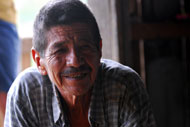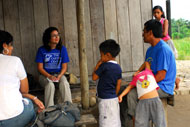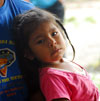Buenaventura Morales has a kind face worn weary from life, and friendly eyes that hide the depression plaguing him since he fled his native Colombia after massacres to his village in 2004. His wife died along the way, and he said he feels unable to support his four children by himself; he can't find a job in this poor border region of Ecuador. He plans to rent a small plot of land nearby to grow rice and trade it among the large refugee community here. Life on the border between Ecuador and Colombia is tough, and complicated.
"Ecuador and Colombia share a border with complicated problems from underdevelopment, guerrillas, and drugs," said Jennifer McCoy, director of the Americas Program at The Carter Center. "The ongoing conflict in Colombia spills over, in particular with many refugees fleeing into Ecuador. This puts additional burdens on Ecuador's poor northern border province."
The Carter Center is conducting a conflict-related development analysis in two towns along the Ecuador northern border with support of the U.N. Development Programme (UNDP) and in collaboration with two grassroots Ecuadorian nongovernmental organizations (Fundación Futuro Latinoamericano and Fondo Ecuatoriano Populorum Progression), which have been working at the border for more than 20 years). The analysis focuses on development in the border zone, including access to justice and human rights, citizen security, and youth and social inclusion. The analysis will serve as input for the creation of public policies for development in the northern border zone by Ecuador's government.
Change comes in small forms. For example, the conflict analysis encourages inclusion by promoting the role of local organizations, such as those empowering traditionally marginalized groups to participate in local decision-making and politics. This includes organizations that educate women and provide basic services like pediatric care for the poor.
"Women were invisible before," said Rosa Lopez, president of the Frente de Mujeres de Sucumbios, a women's coalition that provides leadership training and owns a small women's hospital. "Now, when the province needs something, women are at the forefront of efforts."
The conflict analysis methodology used by The Carter Center and UNDP is unique in its approach, which can be applied to conflict situations around the world.
"For each issue, we determine the dimensions in the border zone that are feeding the conflicts as well as the actors, organizations, and players in the northern border zone that have potential to be agents for peace," said Michael Brown, coordinator of the UNDP in the northern border zone of Ecuador. "The analysis is also unique because it looks at things from a development programming perspective, so you understand the realities of the border zone; you understand the challenges that are faced and the potential for change."
One conflict identified is the massive environmental and health damages caused by oil companies, which have left some 71,000 polluted areas across Ecuador.
Carlos Rodriguez is a resident of Barrio La Florida, a community where the primary water source glistens with petroleum and the air is thick with the stench of oil.
"My wife has breast cancer and I have respiratory problems," he said. "My livestock have all died and no crops will grow."
The analysis also identifies the different actors in the conflict, including indigenous communities, which are against oil extraction in the Amazon, and local authorities, who highlight the employment provided through oil. Without substantial reforms in regulating the oil industry, the conflicts may not be resolved.
Improving conditions in the area, which is crowded with asylum seekers, underdeveloped, and heavily polluted, will take time. Investing in the region, promoting bi-national initiatives, and giving opportunity where there was none before is an important first step toward change.
 |
All Photos: Deborah Hakes Buenaventura Morales, an asylum-seeker in the northern border region of Ecuador, fled his native Colombia in 2004. "We have come, we have suffered," said Buenaventura. "Some days there is work, most days not." |
 |
The Carter Center consortium's conflict-related development analysis works with local women's organizations to encourage social inclusion to women, a traditionally marginalized group in Ecuador. |
 |
More than 58,000 Colombians in Ecuador's northern border are in need of international protection; thousands more remain unregistered and therefore invisible, according to the Office of the U.N. High Commissioner for Refugees. |
 |
The Carter Center's conflict-related development analysis recommendations will serve as inputs for the creation of public policies for development in the northern border zone by Ecuador's government. |

Please sign up below for important news about the work of The Carter Center and special event invitations.